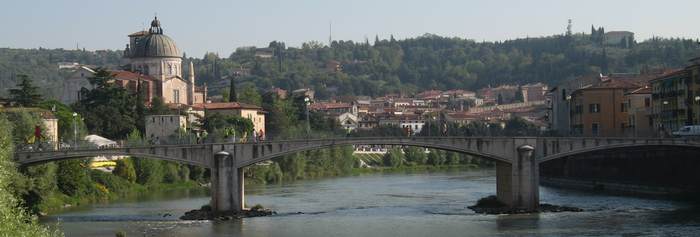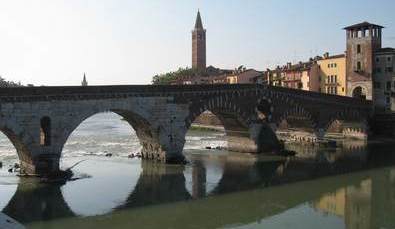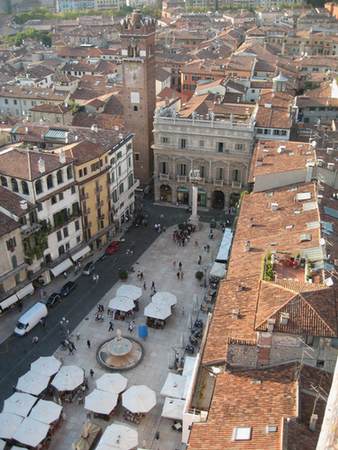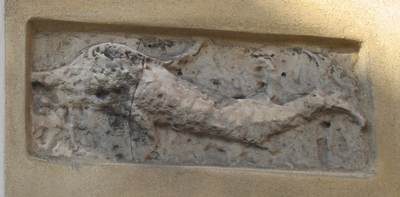Verona (Veneto)
Verona is the provincial capital of the Veneto region in Northern Italy. The ancient part of
the town is in a loop of the Adige River just East of Lake Garda. About 300 hundred
thousand people live in the greater Verona area, which originated around the 6th
century BC.
The history
of the city can be broken into 4 periods each showing
their architectural face throughout the city; Roman period, Middle Ages, Scaliger period and the
Venice Domination.
Over the centuries this city was controlled by the Euganeans, Romans,
Goths, Lombards, Napoleon, Austrians and finally became part of Italy in 1866.
The city
lies in the crossroads of many different civilizations gone by, hence it's varied
past. It is now officially deemed a world heritage site and has much to offer for the
tourist.
It took me just under 3 hours to get here by train from Florence. The train
station was very nice and the city in general was fairly clean and lacked the many street
beggars prevailent in Florence. Most of the streets in the ancient part of the town
were free of cars and all the sidewalks were spacious. I never had to hug walls as
cars raced by.

During the Scaliger period Castel Vecchio was completed in 1375 just next to the Adige River.
Then the ponte scaligero (scaligero bridge) was immediately build across the river
to accomodate the inhabitants of the castle. This badly patched together photo(s) shows
you the bridge and how much the river bends. I counted 11 bridges spanning the river. The bridge
at the far right of the picture is named Ponte Vittoria.

If you follow the river downstream to Ponte Vittoria and look even further downstream
you can see Ponte Garibaldi with Church of Saint Bernardino in the background.

Walking even further downstream along the Adige River we come to ponte pietra (rock bridge).
This bridge was originally part of the Roman period. Some of the original bridge remains, but
most of it was destroyed in April 1945 during WW2. The bridge was carefully reconstructed
from material salvaged from the bed of the Adige river, where possible.

If we stay on the left side of the bridge and go up a steep hill and
stand next to Castel San Pietro it is possible to look down towards
the whitish bell tower of the duomo with Ponte Pietra stradling the Adige River.
At this point in my journey I was begining to look for the Bed & Breakfast I had
made a reservation for. I overshot my elevation when I walked up this high and had to go
down the other side of the hill (to the left of this photo).
As I walked along and asked for directions, the natives responded very friendly and
I never got bad vibes from anybody here. Of course my Italian is better than it
was 2 years ago so I can actually communicate now.

Going back into the center of the old part of the city, it is well worth it to find the
Torre del Comune. It is a tower with a modern day elevator inside. Once at the top
it is possible to get a 360 degree view of the city. Looking almost straight down, we
can see Piazza delle Erbe, which is one of the main tourist attractions of the city.
It is a market place lined with shops, bars and restaurants. The balcony which Juliet
supposedly stood on when she had the night time conversation with Romeo would be at the bottom
of this picture and back about 50 meters and inside a little courtyard.

You might be surprised to know that Verona had a fully functional gladetorial arena, which
of course was also used as an amphitheatre especially after
325AD when emperor Constantine forbade gladiatorial performances.
The outside measurements of the entire complex is 152 by 122 meters. It is the 3rd largest
of it's type in Italy.

As I entered the amphitheatre and walked around, I noticed the stone seating that lined
the inside which provides seats for thousands of people. I kept seeing
fossil imprints in the stone. One of them was wider in diameter than the length of my shoe (as pictured).
I am curious what the ancient Romans thought of these fossil imprints?
I assure you
these were not graffiti carvings because I found them everywhere in the arena in all sizes.

As I walk through European cities, I often look for little symbols and things embedded
in the walls that reveal clues to the city's past. It is often the overlooked markings
that hold the sublime facts of a city's past. The things which have all the glitz and glamour
attached are often fancied up fakes. Anyways, here is a little base relief I found that is worn down.
It looks like some kind of a fish, but has a head area shaped kind of like a dolphin. It
would be interesting to find out what this means and what significance it is.
*
One of the biggest curiosities of this city is the fact that is the setting for the
Shakespeare play "Romeo and Juliet". However, the story of Romeo and Juliet did not originate
with Shakespeare. There are in fact 2 Italian versions of the story predating any non-Italian
versions.
Italians Luigi da Porto and Matteo Bandello each had versions in 1530 and 1554 respectively.
Then Pierre Boiastuau adapted Bandello's version and translated it from Italian to French
in 1559. It was Boiastuau's account that was translated into English in 1567 by William
Painter. Shakespeare's first publication of the play was in 1597.
In any case, the story of Romeo and Juliete is based on fact.
There were in fact 2 rival families living in Verona,
the Montecchi (Montagues) and the Capuleti (Capulets) as was recorded by famous
Italian poet Dante.
Lance Dooley is studying sculpture in Florence, Italy.
Contact lance at: lance@lancedooley.com
[back to main Italy page]







